10 concept cars that saw in the 2000s in style
The 2000s was, in retrospect, a rough old decade, defined by terrorism, war in the Middle East, and the financial crisis later in the period.
It’s interesting to see how the zeitgeist of an era is reflected in its transportation. If the 1990s were bright and optimistic, and its cars a mirror of that with their vibrant colours, friendly forms and zany patterns, cars of the 2000s definitely matured, with low-key colour palettes, minimal ornamentation, and simpler forms—outside of experimentation by the likes of BMW and Renault.
Thankfully though, creativity was still alive and well in the world of concept cars, and was perhaps becoming an increasing outlet for designers’ optimism, even if many shapes would never make it through to production or your nearest showroom.
To demonstrate just how stylish the 2000s could have been, we’ve selected ten concepts that showed drama, beauty, and innovation hadn’t been forgotten—they were just confined to motor show turntables.
Once again we’ll be steering clear of concepts that strongly previewed production cars, so no Land Rover LRX (Evoque), no Fiat Trepiùno (500), and no Audi Le Mans (R8).
Naturally, we’ve had to leave many more off the list (our shortlist included everything from the Audi Rosemeyer to the GT by Citroën, designed for the Gran Turismo video game)—but let us know some of your favorite concepts from the 2000s in the comments below.
BMW M1 Hommage (2008)

We could have included several 2000s BMW concepts on this list, from 2006’s throwback Mille Miglia to 2008’s clever but slightly disturbing Gina, with its peel-back bodywork. But little gets the emotions flowing like the return of a famous name—and in BMW circles, none is more famous than M1.
BMW has pulled a silk cover off several M1-style supercar concepts over the years, but 2008’s Hommage (and yes, it’s double-m here) was overt. Taking direct inspiration from Giugiaro’s original, it was low-nosed and sharky, though BMW never revealed its powerplant.
The work of Chris Bangle and Adrian van Hooydonk, it purely served as creative inspiration for BMW’s designers, and if it inspired any one model, the subsequent BMW i8 would be it. While the i8 ditched many of the Hommage’s cues, it did retain the concept’s eye-catching floating-buttress design over the rear lights.
Jaguar R-D6 (2003)

The front end of the Jaguar R-D6 shows how narrow the line is between the well-executed and merely average. With its round grille and four headlights, it clearly references the old Mk II Jaguars, yet it’s far easier on the eye than the front of the 1999 Jaguar S-Type ever was.
Connecting those headlights undoubtedly helped, just as it did with the Jaguar XF that arrived in 2007. Both were the work of Ian Callum and his team, but while the XF was a traditional saloon, the R-D6 had an (at the time) unfashionably short rear end rather than a full sedan’s trunk.
Somehow, like the front end, that worked too, perhaps helped by the broad, coupe-like rear wings. But the R-D6’s real party piece was inside: an elegant, upmarket bar-style ambience, mixing black walnut veneer, leather, and aluminum, all subtly lit with red mood lighting.
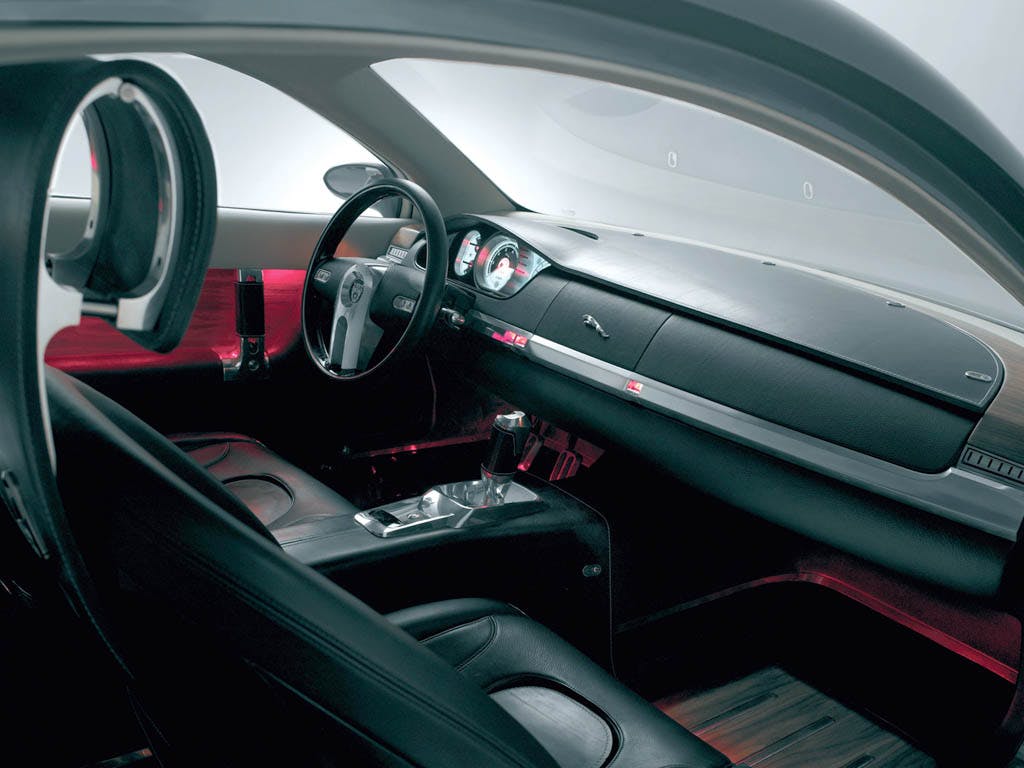
JLR could do much worse than give it another look, should it need any inspiration in its modern range…
Pininfarina Birdcage 75th (2005)
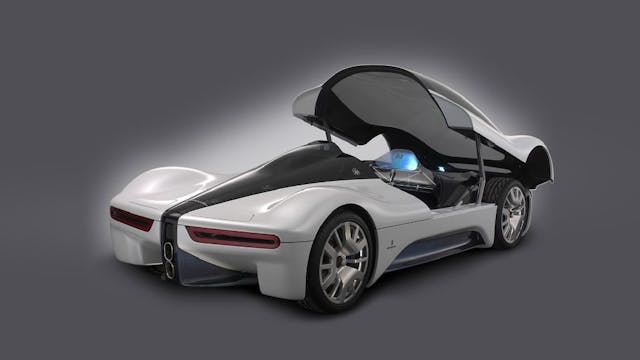
The original Maserati Birdcage—more correctly known as the Tipo 61—was a race-winning sports car built between 1959 and 1961 using a complex tubular spaceframe chassis, that construction lending the car its unusual nickname. Light and fast, it took two consecutive victories at the 1000km Nürburgring in the early 1960s, with Stirling Moss and Dan Gurney sharing the driving in 1960, though it never quite sealed a Le Mans win.
To celebrate its 75th birthday in 2005, and its association with Maserati, Pininfarina brought the Birdcage back—albeit based on the platform of the MC12 supercar and its 6-liter V-12, a far cry from the original’s inline-four.
Easily the most dramatic concept of that year, the Birdcage used a large, single-piece canopy rather than doors, and while lattice-like structures visible through the glass were mere lip service, the MC12’s own race-winning heritage at least had that single-shell construction in common with the original.
Cadillac Sixteen (2003)
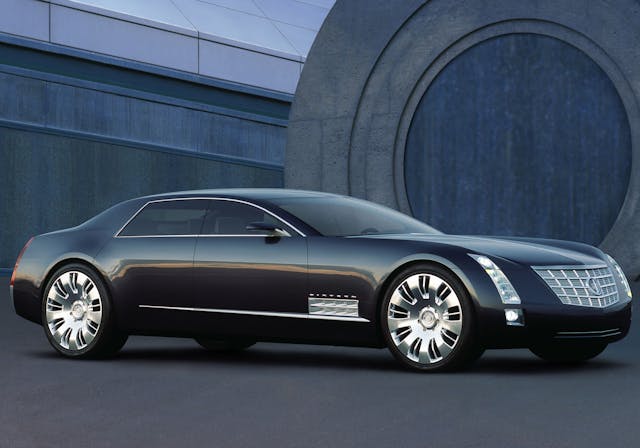
American brands had consistently good form with concept cars in the early 2000s, and arguably still do today. Much of that seems down to reviving ideas from the U.S. car industry’s grandest eras either side of the Second World War, and 2003’s Cadillac Sixteen used elements of both.
The name gave the game away somewhat, the car using a 13.6-liter sixteen-cylinder engine, harking back to Cadillac’s V-16s of the 1930s. The enormous body, meanwhile—nearly 19 feet long—seemed a throwback to the enormous Caddies of the 1950s. None of those would do a claimed 200 mph, though …
Predictably, the design—the work of a team led by Wayne Cherry, whose CV includes everything from the Vauxhall Calibra to the Hummer H2—never got close to production, but as a reminder of where Cadillac used to sit, mentioned in the same breath as brands like Rolls-Royce, it resonated powerfully.
Ford Visos (2003)
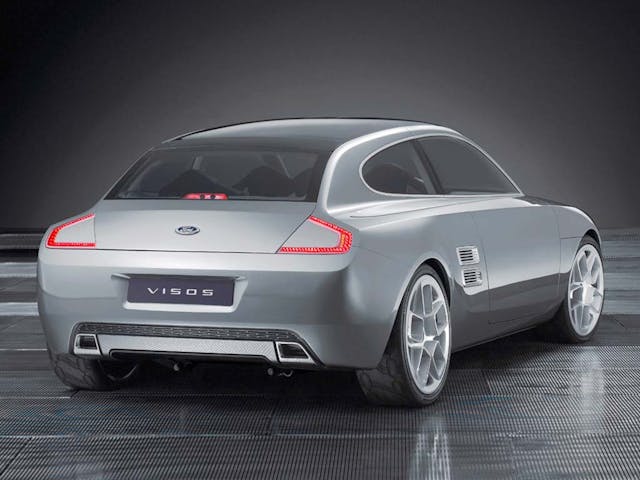
This is the concept that had all the car mags running “new Capri!” covers back in 2003—and one look at some of the details and you can see its designer, the late Chris Svensson, had an eye on Ford’s iconic two-door when this was on the drawing board.
Check out that curve to the rear window for instance, or the twin vents in the rear quarter panels. The rectangular headlights and slim grille also remind us (and clearly those contemporary car magazines) of the Capri too, though the rear end of the Visos was more wagon than fastback.
It was a little different under the skin too. It spun all four wheels rather than just the rears, and packed a 350-hp, 3.0-liter inline-six instead of four-cylinders and V-6s. Then again, you could say it was taking inspiration from the four-wheel drive Capri that never made it to showrooms. What you also can’t see are the active aerodynamic elements, activated in the car’s sport driving mode, which also flipped down the little camera stalks serving as mirrors, for an even cleaner look.
Peugeot 907 (2004)

Here’s a concept you can still see today if you’re fortunate, and willing to make a trip to Musée de L’Aventure Peugeot in Sochaux, eastern France, because it’s part of Peugeot’s large and impressive collection of historical models.
The 907 is itself large and impressive, at least in presence—at under 14.5 feet long it’s actually shorter than a modern Porsche 911. That’s all the more impressive when you consider there’s nothing less than a 6-liter, 500-hp V-12 sitting lengthways under the hood.
We’d love to have sat in on the (no doubt wine-lubricated) meeting at which that was decided upon, while the classic GT proportions have more than a hint of Ferrari 599—impressive, as the 907 predated it by three years. It’s just a shame it was created during Peugeot’s massive-grille phase; the 307-style front end really doesn’t suit it.
Lancia Fulvia (2003)

Of all the cars on this list, 2003’s Lancia Fulvia concept probably hurts the most. None looks quite so ready for production, and given the concept was based on Fiat’s pert Barchetta, there’d have been a way, had there been a will.
Alas, it was not to be, and now the Fulvia lives in Fiat’s Heritage Hub in Turin, one of the great missed opportunities. Styled by Flavio Manzoni—now design director at Ferrari—it was designed to look as if it had evolved from the 1960s original, much like the Porsche 911 has evolved over time. And boy did it hit that target.
While modestly powered using the Barchetta’s 1.8-liter four, it was designed to weigh barely more than the original Fulvia, at 2182 pounds. Had Lancia made it, enthusiasts 20 years on would no doubt be falling over each other to buy one—though the elephant in the room is whether Lancia would have sold many to start with.
Renault Fluence (2004)
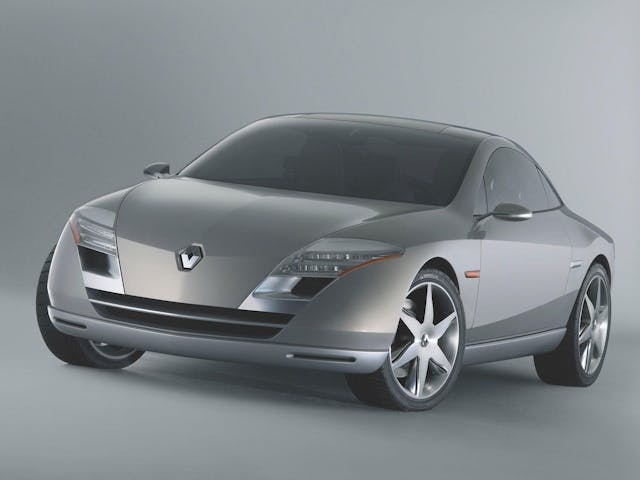
The name might have appeared on a Euro-market Renault production car, but the concept itself never saw the light of day—unless you draw a wavy line between it and the Laguna Coupé that arrived four years after the Fluence debuted at the Louis Vuitton Classic Concours d’Elegance at Waddesdon Manor in 2004.
Like other Renaults penned under the direction of Patrick le Quément, the Fluence was daring, but it could also be called classically beautiful, with elegant lines and excellent proportions—the latter a surprise considering a front-wheel-drive layout and sizeable 3.5-liter V-6 engine.
The heavily tapered tail and largely grille-less face are elements that could never really make it into a production model at the time, but the Fluence showed there was more to Renault’s 2000s European portfolio than attention-grabbers like the Avantime. The eventual Laguna Coupé (first concept in 2007, then production in 2008) wasn’t quite as pretty, but it was an admirable effort.
Saab 9-X (2001)

Saab wasn’t just still around in the early 2000s, but still in a relatively strong position, selling respectable numbers of 9-3s and 9-5s. It also had a regular line in concept cars, of which 2001’s 9-X is probably most fondly remembered.
Had it come to market, we’d be looking at a rival for the Audi TT, albeit done in a typically offbeat Saab way. Among its designers was Michael Mauer, who’d later work on the Smart Roadster, and is now design director at Porsche, and we reckon there’s a hint of both brands in this car’s styling.
There are traditional Saab cues too, though, such as that heavily curved windscreen. Saabs can’t forget practicality, so the rear end featured a station-wagon layout, while a 3-liter turbo V-6 (along with all-wheel drive, and a manual gearbox) handled propulsion. Perhaps, if it had ever reached production, it could have worn the name Sonett …
Chrysler Airflite (2003)
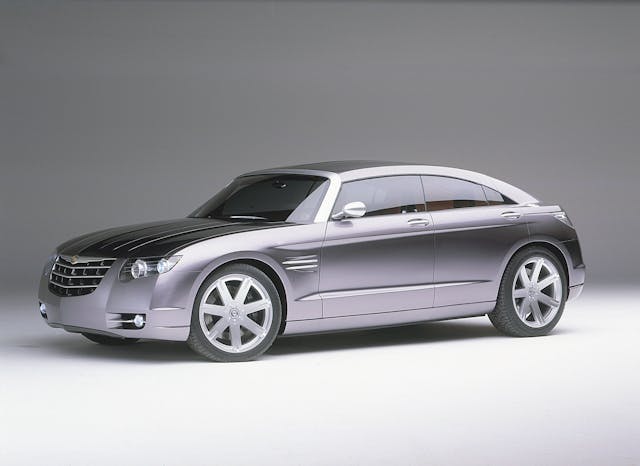
If the Airflite looks familiar, like a stretched Chrysler Crossfire, it was not a precursor to it, even though it arrived one year earlier than the production coupe. Instead, it was itself an offshoot of the original Crossfire concept, and an exploration by Chrysler into a possible art deco direction for the brand’s styling, one that never truly materialised.
It’s arguably a lot more successful than the Crossfire, the extra length, and doors, giving it an elegance the coupe lacked. Frameless windows harked back to big 1950s and 1960s hard-tops, and like many concepts of the era, wood—in this case, for the floors—was still in fashion for interior furnishings.
Power from a (no doubt Mercedes-derived) 3.5-liter V-6 went to the rear wheels, so there was tradition there too. Chrysler’s current range is a shadow of its former self, only the dated 300C upholding any interest for enthusiasts. Perhaps the brand should shuffle through the archives and rediscover some of its early 2000s boldness.
***
Check out the Hagerty Media homepage so you don’t miss a single story, or better yet, bookmark it. To get our best stories delivered right to your inbox, subscribe to our newsletters.
Via Hagerty UK
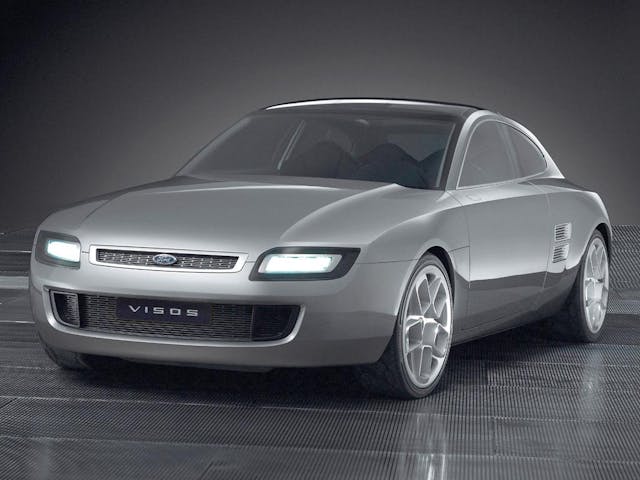

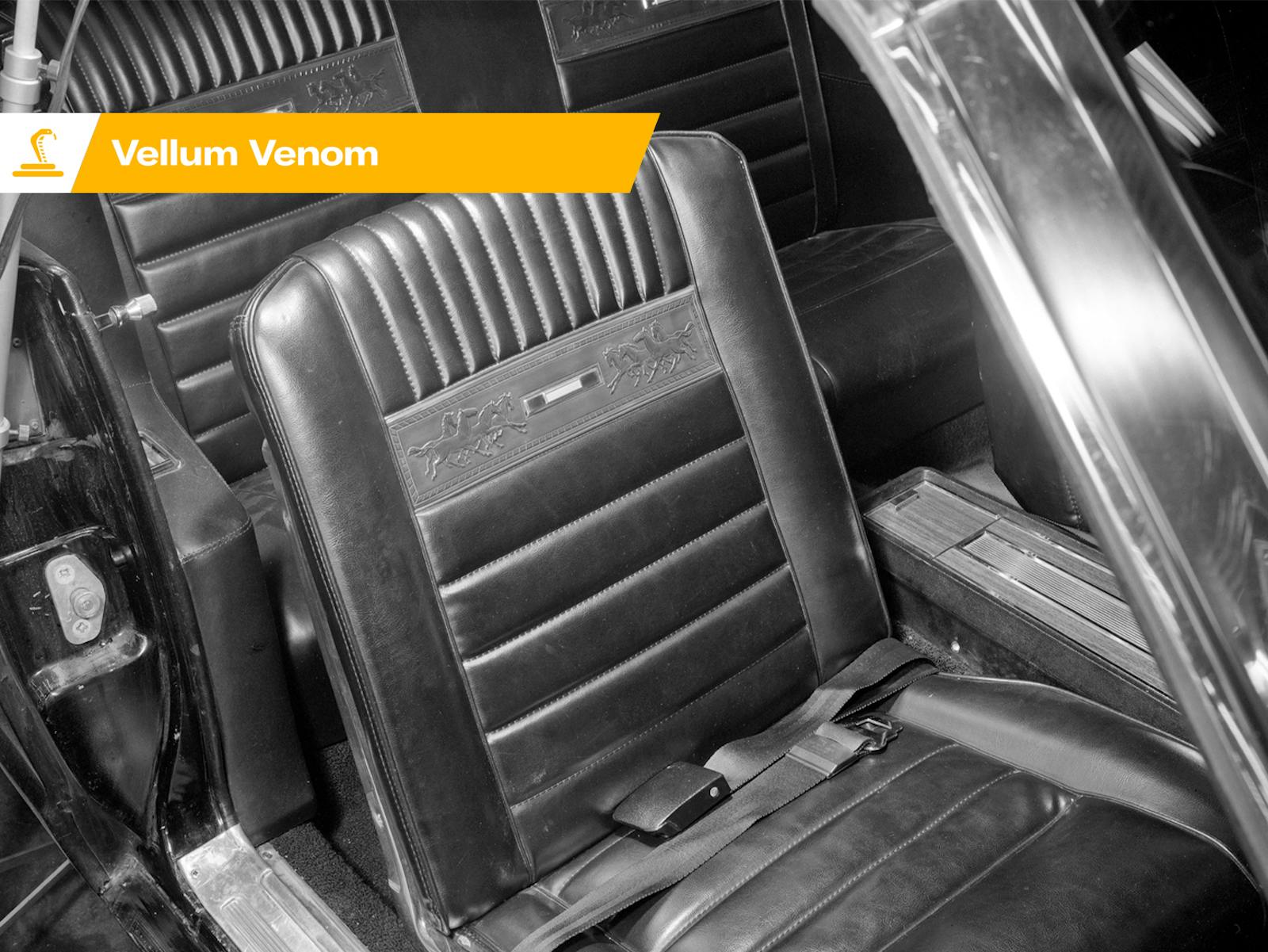
Cadillac should have–and still could–build the Sixteen. A spectacular car in person in 2004. It would be so today. A real Standard Of The World. Different than the new EV hatchback for $300K whose name I cant remember…
Exactly.
The Blackwing had that same ability; to show the world GM was serious again about building a luxury sedan. Instead we get a CT5, based on the perfectly good, but not a E-Class/5-Series killer Impala chassis.
GM has the resources to make a halo car. They have the engineering prowess. They choose to be middling.
The Sixteen would have turned Cadillac around much sooner and re-established the division’s prestige image that GM squandered for years while floundering around for a new and more exciting image. This was a masterpiece automobile surely to become an icon and a great opportunity unwisely squandered by GM management when they didn’t build a production version.
The problem is you can’t just leap from making a sub-$100K car to making a $300K car and expect the auto-buying world to take you seriously. Owners or prestige vehicles expect to be treated differently throughout the entire ownership process–from purchase through maintenance and beyond. This requires a devoted manufacturer willing to invest the resources into curating and training dealers, building, maintaining and enforcing standards. It requires separation from plebeian brands. In other words, it required far more than Cadillac was able to demand of GM at the time, or probably even today.
Two words as to why this never happened, and as to why GM continued to lose: “Bean” and “Counters”.
or “Mary” and “Barra”
Katech was contracted to develop The Sixteen’s engine. Founded by Fritz Kayl and Warren Frieze, Katech is best known as the engine builder for the famous GM Corvette Racing Team. Check ’em out at katechengines.com.
They built the LS7 in my ’69 C3.
Well worth the drive to Michigan to have them do the labor on the LS prior to install. They helped design aspects of the motor with GM, they knew how to make oodles of power while keeping it relatively tractable for street use.
This goes on for generations before Barra.
Stempel and Murphy were on the helm when they ignored foreign competition and the 70s gas crisis. Roger Smith didn’t do the company any favors by losing money and market share for two decades, giving us gems like the Cutlass Ciera, and essentially killing multiple brands while launching winners like Geo and Saturn.
C’mon. Last good leader they had was Sloan, and he’s been gone for five decades. They at least have a direction now. Maybe one I don’t agree with, but it’s better than fifty years of rudderless confusion.
And way better than Ford’s let’s stop making everything that isn’t a SUV and hope nobody changes their minds in the future approach.
Why would the assumption be that the 3.5L would be derived from Mercedes for the Airflite?
Chrysler not only had a 3.5 before the Mercedes takeover, but even updated it after the takeover was finalized, and it even got its own bore/stroked variation a bit after that.
Even if Mercedes had its own 3.5L, I’d bet the Chrysler variation was cheaper to produce and pluck from the line for a one-off concept car.
Mercedes has had a 3.5 for a long time; the M272. It was subsequently refreshed in the mid-2010s to the M276 .
Absolutely no relation (thankfully) to the Mopar 3.5. The 272 had some balance shaft issues early on, but it holds compression for longer than 60k miles, and is a vastly better powerplant than the Chrysler variant.
I liked the retro look of Jaguar’s F-Type concept (2000) and Ford’s Forty Nine concept (2001).
Oh for sure love it along with the Ford Viso
As great as the Sixteen was it would never have translated to production well and most would never have paid the price of what it would have cost for that Cadillac. GM needed to focus on their core product but they never did with the revolving door of Cadillac Management.
Whereas most of these are impressive, and a few incredible; the one which which had the best chance would be Ford’s Visos.
Attractive and even practical, it might have been a best-seller.
I’d have taken a look, (but in my dream, it’s the BMW I buy.)
I read the article because at a glance the thumbnail read to me as “Ford Virus”
Many of these concepts read as cowardly to me… smoothing out sections that would be better served with crisp lines. The very generic sucked-on cough drop look we have been cursed with since the Ford Taurus was first a sales success.
While I accept that concept cars get to be fanciful (so many have scissor doors or other craziness usually) most of these have proportions that shouldn’t ever make production. Sadly the “coupe roofline” on 4 doors has become a common thing making a pile of vehicles that aren’t that useful (if you are going to have 4 doors a 6′ + adult should be comfortable in the back seat not looking at their own knees).
Don’t forget the BMW Concept CS, which evolved into the new 8.
The Ford Forty Nine from 2001. What a sexy car!!!
Agreed. The Forty Nine concept had me reaching for my wallet, then… nothing
They are OK, but the aerodynamics makes almost all look somewhat like the same jelly bean shape. I still long for the days when cars actually looked different from year to year and from model to model and weren’t the same for a 10 year model run.
I was thinking the same thing about the jelly bean styles. It is like “more of same” to me.
Strictly an American Car guy. BUT, the BMW is my choice, beautiful.
It was pretty much a yawn until I got to the Bimmer. Simply gorgeous and one I that could easily lust after. I see some R8 in it. That’s not all bad.
That 2003 Ford Visos sure looks a lot like a 2007-13 Volvo C30, and I believe Ford owned Volvo in the first 10 year of this century.
Totally agree. That and the Volvo C30 and 1800ES were the first cars that came to mind.
Owning the attention getting 1800ES, I’ve slapped a mostly glass tailgate/hatch on that Visos and gone to market.
Then again, I’m pretty sure it would have been a “rest of the world” vehicle unfortunately. American Bean counters (and too many others) have lost the vision of “Halo” cars, cars that aren’t necessarily meant to make money, but are meant to attract potential buyers to the showrooms. For Volvo is was the P1800/S/E/ES – the volumes were never going to be there for profits, but it was a pretty reskin of a platform.
I’ve never had any interest whatsoever in a Stupid Upside down Vehicle. Don’t want to even try parking them. My GTI or a C30 IMHO are far better personal transport & parking.
Totally agree. The Volvo C30 and 1800ES were the first cars that came to mind.
I always thought the Cadillac Elmira was going to be my next car. It had the edgy Caddy design vibe with a long nose, short deck awesomeness in a two-door coupe. I was looking forward to being an empty-nester and buying a car for ME.
Elmiraj
The Cadillac 16 was the biggest missed opportunity of this lot. A potential world-class flagship that would have been an object of desire for wealthy and discerning buyers around the world. I have seen both the 16 and the upcoming Celestiq in person at Amelia Island. The former was (and is) a stunning motorcar, the latter … not nearly as much. I have a feeling that without some significant styling revisions the Celestiq may end up being one of GM’s biggest blunders ever.
I’ll take the Maserati Birdcage and the Cadillac. Both are outstanding and will always be remembered. What a shame they were not made. Perfect recreation projects for billionaires with taste.
I remember Lincoln proposing a Continental convertible. Do you have images of that?
You missed the best, Audi’s Avus!
That one came out in 1991, a little too early for this article.
Oops. How time flies. Little di we know then …
I was at the Detroit Auto Show when the Audi Avus was on display. It was truly remarkable. Yes, too early for this comparison, but my favorite concept I have seen.
That Caddy oozes class! The rest of ‘em, Meh!
The BMW I think is the coolest looking. But I like that Cadillac Sixteen too. Although I’m an American car guy who drives an old but nice ’65 El Camino, I can’t take my eyes off that Red BMW. And I never was a Red Car fan. Hmm…